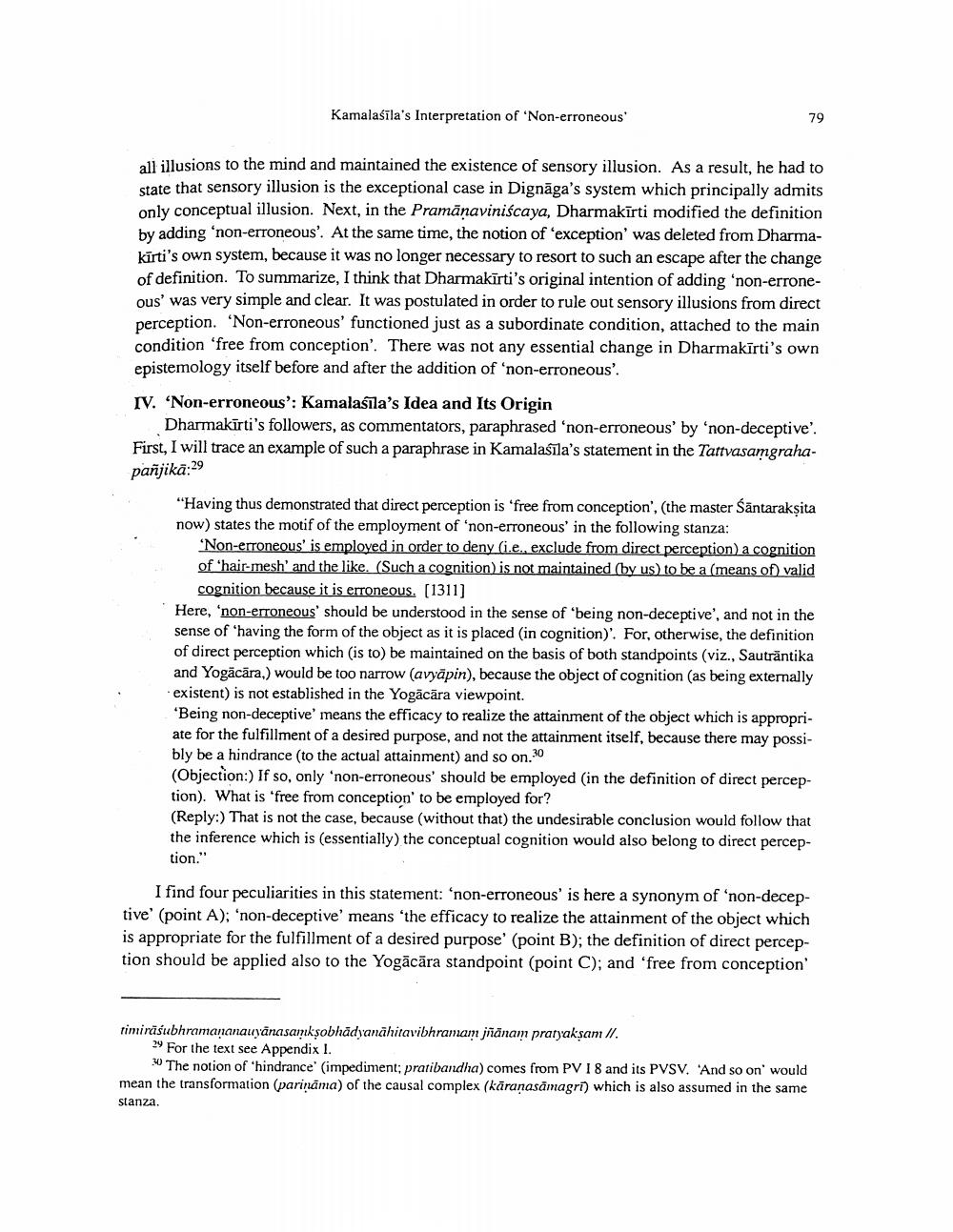________________
Kamalaśīla's Interpretation of 'Non-erroneous
all illusions to the mind and maintained the existence of sensory illusion. As a result, he had to state that sensory illusion is the exceptional case in Dignāga's system which principally admits only conceptual illusion. Next, in the Pramāņaviniscaya, Dharmakīrti modified the definition by adding 'non-erroneous'. At the same time, the notion of 'exception' was deleted from Dharmakirti's own system, because it was no longer necessary to resort to such an escape after the change of definition. To summarize, I think that Dharmakīrti's original intention of adding 'non-erroneous' was very simple and clear. It was postulated in order to rule out sensory illusions from direct perception. 'Non-erroneous' functioned just as a subordinate condition, attached to the main condition 'free from conception'. There was not any essential change in Dharmakīrti's own epistemology itself before and after the addition of 'non-erroneous'.
IV. 'Non-erroneous': Kamalasīla's Idea and Its Origin
Dharmakārti's followers, as commentators, paraphrased 'non-erroneous' by 'non-deceptive'. First, I will trace an example of such a paraphrase in Kamalašīla's statement in the Tattvasamgraha
pañjikā:29
"Having thus demonstrated that direct perception is 'free from conception', (the master sāntarakṣita now) states the motif of the employment of 'non-erroneous' in the following stanza:
'Non-erroneous' is employed in order to deny (i.e., exclude from direct perception) a cognition of 'hair-mesh' and the like. (Such a cognition) is not maintained (by us) to be a (means of valid
cognition because it is erroneous (1311) Here, 'non-erroneous' should be understood in the sense of being non-deceptive', and not in the sense of having the form of the object as it is placed (in cognition)'. For, otherwise, the definition of direct perception which is to be maintained on the basis of both standpoints (viz., Sauträntika and Yogācāra,) would be too narrow (avyāpin), because the object of cognition (as being externally existent) is not established in the Yogācāra viewpoint. "Being non-deceptive' means the efficacy to realize the attainment of the object which is appropriate for the fulfillment of a desired purpose, and not the attainment itself, because there may possibly be a hindrance (to the actual attainment, and so on..0 (Objection:) If so, only 'non-erroneous' should be employed in the definition of direct perception). What is 'free from conception to be employed for? (Reply:) That is not the case, because (without that) the undesirable conclusion would follow that the inference which is essentially) the conceptual cognition would also belong to direct perception."
I find four peculiarities in this statement: 'non-erroneous' is here a synonym of 'non-deceptive' (point A); 'non-deceptive' means the efficacy to realize the attainment of the object which is appropriate for the fulfillment of a desired purpose' (point B); the definition of direct perception should be applied also to the Yogācāra standpoint (point C); and 'free from conception
timiräśubhramananauyānasamkşobhadyanāhitavibhramam jñānam pratyakşam II.
24 For the text see Appendix I.
The notion of 'hindrance (impediment; pratibandha) comes from PV I 8 and its PVSV. 'And so on' would mean the transformation (pariņāma) of the causal complex (kāranasāmagri) which is also assumed in the same stanza.




